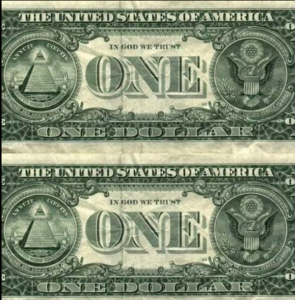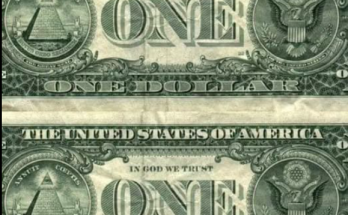
The Secret History of Marked Money: How Chop Marks on U.S. Dollar Bills Reveal a Hidden Global Journey
Most people handle cash without thinking—folding it into wallets, slipping it across counters, or stuffing it into tip jars. A dollar is a dollar, simple and anonymous. But every once in a while, a keen observer does a double-take: a crisp U.S. bill stamped with a tiny red star, a faint pentagram, an unfamiliar letter, or a mysterious emblem that definitely wasn’t printed at the Bureau of Engraving and Printing.
They’re called chop marks, and while they may look like scribbles, graffiti, or accidental stains, they actually carry hidden stories. Each mark, however small, represents a chapter in that bill’s improbable journey—a global path through hands, markets, money changers, and cultural rituals that most Americans never imagine.
The secret world of marked money is a world of wanderers.
A Currency That Refuses to Stay Home
Unlike many national currencies, the U.S. dollar is a world traveler. It crosses borders like a seasoned backpacker, slipping into pockets and registers on every continent. It circulates in bustling markets from Hong Kong to Nairobi, used in trade deals, tourist exchanges, and underground economies.
Billions of physical dollars exist outside the United States at any given moment—so many that some countries effectively use the dollar as their unofficial or even official currency. That worldwide ubiquity is exactly what exposes these bills to the practice of chop marking, a tradition borrowed from centuries of trade history.
The marks tell us one thing above all:
this dollar has a past.
The Ancient Tradition Behind the Modern Mark
Chop marking began centuries ago during periods of intense international trade. Merchants in China, the Middle East, and Southeast Asia would test the authenticity of foreign silver coins by stamping them with their personal symbol. That stamp—the “chop”—was a sign of approval:
This coin is real. This money can be trusted.
Coins might accumulate dozens of such chops over decades, forming patterns like tattoos on metal.
Fast-forward to today. The currency has changed, and the age of silver coins is long gone, but the tradition survived. In parts of Asia, Africa, and Eastern Europe, money handlers—currency exchangers, wholesalers, street vendors, or even small shops—still stamp bills as a quick method of tracking verification.
Each stamp offers a message:
-
This bill passed through me.
-
I verified it.
-
I vouch for its authenticity.
-
I accept and circulate it.
It’s not an official system but a cultural legacy. And the U.S. dollar, the world’s most traveled banknote, becomes a perfect canvas for these ancient fingerprints.
More Than Verification—Sometimes A Ritual
While many chop marks are practical, others are symbolic or spiritual.
In some regions, symbols like stars or pentagrams don’t represent the occult—they’re protective marks used to bless money, ensuring it circulates quickly or brings prosperity. A small red stamp may reflect cultural practices where red ink symbolizes luck, profit, or warding off loss.
In other cases, the marks come from:
-
Religious blessings
-
Good-luck rituals
-
Festival traditions
-
Shop insignias
-
Curiosity or local customs
Imagine a bill stamped during Lunar New Year in a street market in Macau, then later folded into a leather wallet in Thailand, passed to a money exchanger in Laos, carried home by a traveler, and finally spent again at a diner in Oregon.
That bill isn’t just money.
It’s a story.
Initials, Symbols, and Strange Shapes
Collectors who study chop-marked dollars categorize them into a few broad types:
1. Verification Stamps
These are tiny, neat, often geometric shapes used by money exchangers.
Think: circles, diamonds, stars, or symbols resembling seals.
2. Initials
A quick “OK,” “AJ,” “TH,” or a shopkeeper’s abbreviation—fast, utilitarian marks meant for tracking movement.
3. Cultural Symbols
Small animals, sun shapes, spiritual icons, good-luck characters, or symbols of fortune.
4. Mystery Marks
The ones no one can identify—crooked letters, tiny logos, personal imprints. These are often the most intriguing, because the story behind them is lost to time.
To the untrained eye, they look like random doodles. But to a collector or historian, they’re breadcrumbs leading back through invisible trade routes.
The Journey of a Single Bill
Imagine, for a moment, following a single $1 bill.
It leaves a printing facility in Washington, D.C., pristine, crisp, and unmarked. It gets bundled, shipped to a bank in Florida, dispensed in a customer’s withdrawal, and slipped as tip money to a cruise-ship bartender.
The ship docks in Barbados.
The bartender uses it to buy fruit from a street vendor.
The vendor hands it to a tourist from Prague.
The tourist brings it home and exchanges it at a small money booth.
The booth stamps it—tiny initials like an unbreakable habit passed down from the owner’s grandfather.
The bill travels again, carried in the pocket of a student flying to Southeast Asia.
They buy street food in Vietnam.
The vendor sends it to a local exchange.
Another stamp.
Later, a businessman receives it as change in Singapore.
He flies to New York for meetings.
He buys a bottle of water at the airport.
And suddenly, this bill—born in America, nearly forgotten abroad—returns home covered in marks telling the story of oceans, borders, languages, and cultures.
A world map in your hand.
Why Marked Bills Fascinate Collectors
Numismatists—currency collectors—are drawn to chop-marked paper for the same reason archaeologists love artifacts. Each mark is a clue. Not all clues can be traced, but the thrill lies in trying.
Collectors love:
-
Origin mystery
-
Cultural connection
-
Aesthetic uniqueness
-
The contrast between U.S. standardization and global improvisation
A pristine, untouched bill may look more “proper,” but a marked bill feels alive.
It is the difference between a spotless passport and one overflowing with stamps.
A Currency of Memories
What makes marked bills so compelling is the paradox they represent:
The U.S. dollar is standardized, mass-produced, uniform, and carefully regulated—yet once it leaves American soil, it becomes a canvas of improvisation. Its marks, stamps, and symbols transform it into a traveler, a witness, a participant in everyday life across diverse worlds.
Every marked note is proof that money doesn’t just move—it lives.
It passes from hand to hand, culture to culture, moment to moment, leaving behind faint traces of every place it has been.
A stranger’s symbol here.
A faded initial there.
A stamp in a language you can’t read.
All of it quietly whispering:
You don’t know where I’ve been.
But I remember.

